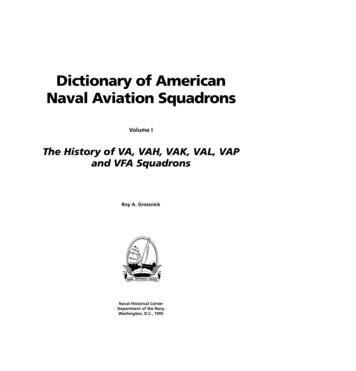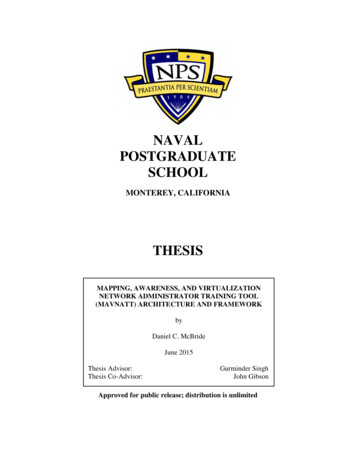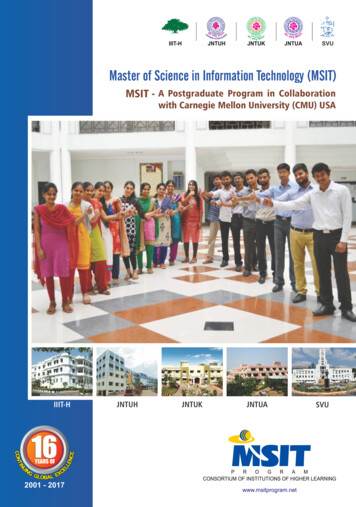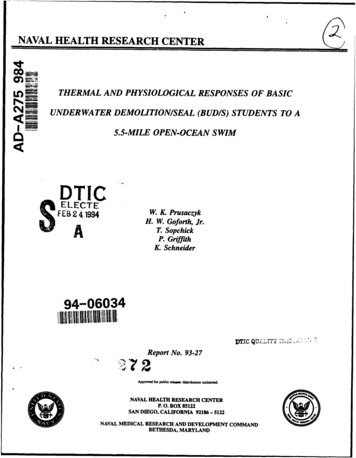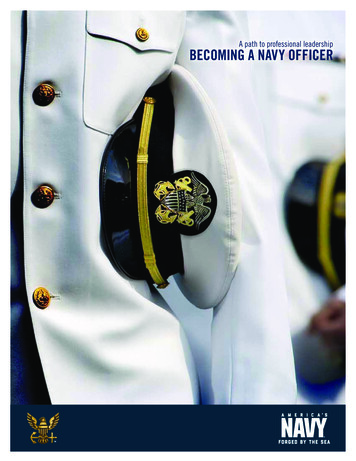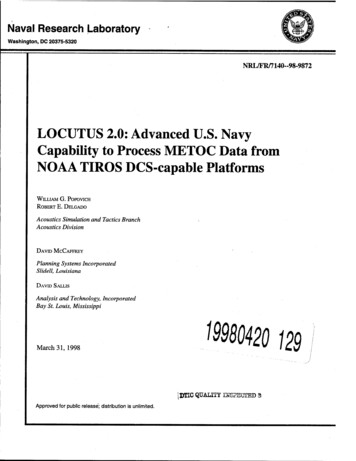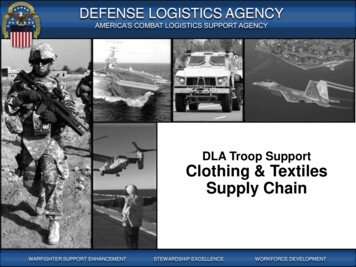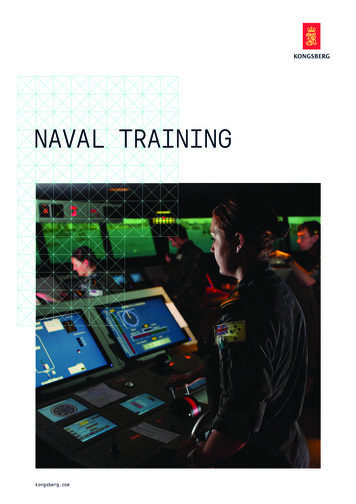
Transcription
NAVALPOSTGRADUATESCHOOLMONTEREY, CALIFORNIATHESISINFLUENCE: THEORY AND PRACTICEbyWilliam G. HansenJune 2013Thesis Advisor:Thesis Co-Advisor:John ArquillaAnna SimonsApproved for public release; distribution is unlimited
THIS PAGE INTENTIONALLY LEFT BLANK
REPORT DOCUMENTATION PAGEForm Approved OMB No. 0704–0188Public reporting burden for this collection of information is estimated to average 1 hour per response, including the time for reviewing instruction,searching existing data sources, gathering and maintaining the data needed, and completing and reviewing the collection of information. Sendcomments regarding this burden estimate or any other aspect of this collection of information, including suggestions for reducing this burden, toWashington headquarters Services, Directorate for Information Operations and Reports, 1215 Jefferson Davis Highway, Suite 1204, Arlington, VA22202–4302, and to the Office of Management and Budget, Paperwork Reduction Project (0704–0188) Washington DC 20503.1. AGENCY USE ONLY (Leave blank)2. REPORT DATEJune 20133. REPORT TYPE AND DATES COVEREDMaster’s Thesis5. FUNDING NUMBERS4. TITLE AND SUBTITLEINFLUENCE: THEORY AND PRACTICE6. AUTHOR(S) William G. Hansen7. PERFORMING ORGANIZATION NAME(S) AND ADDRESS(ES)Naval Postgraduate SchoolMonterey, CA 93943–50009. SPONSORING /MONITORING AGENCY NAME(S) AND ADDRESS(ES)N/A8. PERFORMING ORGANIZATIONREPORT NUMBER10. SPONSORING/MONITORINGAGENCY REPORT NUMBER11. SUPPLEMENTARY NOTES The views expressed in this thesis are those of the author and do not reflect the official policyor position of the Department of Defense or the U.S. Government. I. R. B. Protocol number N/A.12a. DISTRIBUTION / AVAILABILITY STATEMENTApproved for public release; distribution is unlimited13. ABSTRACT (maximum 200 words)12b. DISTRIBUTION CODEADuring the Korean War, Chinese captors of U.S. prisoners employed an unexpected and relatively successfulcompliance program. The Chinese, somewhat afraid of post-conflict repercussions for coercive torture, pursuedtechniques of “social influence” to secure behavioral compliance as well as lasting indoctrination. Although theyfailed in their primary objective to permanently alter beliefs and attitudes, their process illuminated the success ininfluencing individual behavior by interpreting and controlling aspects of group social dynamics.To cope with the daily flood of life’s information, humans have developed cognitive processes to quickly filterdecision-making requests according to probable importance. If determined routine, the person allows learneddecision-making shortcuts to guide his response. A range of psycho-social principles of human behavior underlie this“automaticity” and they can be deliberately triggered, or suppressed, to increase the likelihood of generatingpredictable behavioral responses in an individual.This thesis includes a broad survey of the major theoretical and practical foundations of psychology, propaganda, andmarketing. It identifies the psycho-social principles that most influence a person’s likelihood of complying withbehavioral “requests” and examines a broad selection of social influence efforts for their presence. Finally, this thesisconcludes by assessing the ability of influence principles to secure enduring effects.14. SUBJECT TERMS Compliance, Persuasion, Influence, Propaganda, Heuristics, Social ImpactTheory, Cybernetic Theory, Change Theory, Attitude Change Theory, Reflexive Control Theory,Marketing, Automaticity, Psychological Principles, Perception Bias, Judgment Bias, Habit Formation,Behavior Modification, Indoctrination, Advertising17. SECURITYCLASSIFICATION OFREPORTUnclassified18. SECURITYCLASSIFICATION OF THISPAGEUnclassifiedNSN 7540–01–280–550015. NUMBER OFPAGES32716. PRICE CODE19. SECURITY20. LIMITATION OFCLASSIFICATION OFABSTRACTABSTRACTUnclassifiedUUStandard Form 298 (Rev. 2–89)Prescribed by ANSI Std. 239–18i
THIS PAGE INTENTIONALLY LEFT BLANKii
Approved for public release; distribution is unlimitedINFLUENCE: THEORY AND PRACTICEWilliam G. HansenMajor, United States ArmyB.S., Virginia Polytechnic Institute and State University, 1995Submitted in partial fulfillment of therequirements for the degree ofMASTER OF SCIENCE IN DEFENSE ANALYSISfrom theNAVAL POSTGRADUATE SCHOOLJune 2013Author:William G. HansenApproved by:John Arquilla, Chair, Department of Defense AnalysisThesis AdvisorAnna Simons, Professor, Department of Defense AnalysisThesis Co-AdvisorJohn ArquillaChair, Department of Defense Analysisiii
THIS PAGE INTENTIONALLY LEFT BLANKiv
ABSTRACTDuring the Korean War, Chinese captors of U.S. prisoners employed an unexpected andrelatively successful compliance program. The Chinese, somewhat afraid of post-conflictrepercussions for coercive torture, pursued techniques of “social influence” to securebehavioral compliance as well as lasting indoctrination. Although they failed in theirprimary objective to permanently alter beliefs and attitudes, their process illuminated thesuccess in influencing individual behavior by interpreting and controlling aspects ofgroup social dynamics.To cope with the daily flood of life’s information, humans have developedcognitive processes to quickly filter decision-making requests according to probableimportance. If determined routine, the person allows learned decision-making shortcuts toguide his response. A range of psycho-social principles of human behavior underlie this“automaticity” and they can be deliberately triggered, or suppressed, to increase thelikelihood of generating predictable behavioral responses in an individual.This thesis includes a broad survey of the major theoretical and practicalfoundations of psychology, propaganda, and marketing. It identifies the psycho-socialprinciples that most influence a person’s likelihood of complying with behavioral“requests” and examines a broad selection of social influence efforts for their presence.Finally, this thesis concludes by assessing the ability of influence principles to secureenduring effects.v
THIS PAGE INTENTIONALLY LEFT BLANKvi
TABLE OF CONTENTSI.INTRODUCTION.1A.BACKGROUND .1B.RESEARCH QUESTION .2C.HYPOTHESIS.2D.AREA OF INQUIRY .2E.BODY OF KNOWLEDGE .4F.METHODOLOGY .6II.PSYCHOLOGICAL PERSPECTIVE .7A.MAJOR APPROACHES .71.Behaviorism .7a.Respondent Conditioning .8b.Operant Conditioning .8c.Social Learning Theory .92.Cognitivism .11a.Control Theory .12B.AUTOMATICITY .151.Practice.162.Priming.16C.HEURISTICS .181.Availability Heuristic .202.Anchoring Heuristic.203.Representativeness Heuristic .214.Affect (Attribution) Heuristic .215.Prospect Theory: An Anchoring and Affect Heuristic .22D.DUAL PROCESS MODELS .231.HSM: An Accommodating Model of Persuasion .23a.Co-occurrence .24b.Motivation.25c.Cues .26E.BEHAVIOR AND ATTITUDE CHANGE DURABILITY .281.Change Theory .28a.Inherent Resistance .28b.Social Role Models .29c.Long-term Impact .302.Change Processes .30a.Compliance .31b.Identification .32c.Internalization .333.Habits .33F.GOVERNING PSYCHO-SOCIAL PRINCIPLES .35G.CHAPTER DISCUSSION .371.Psycho-social Principles’ Sufficiency Assessment .38vii
2.III.Perpetuating Influence .39PROPAGANDA AND INFLUENCE .43A.ACADEMIC .431.World War Influence (1914–1949) .44a.Social Conformity .44b.Manipulation of Symbols .45c.Reinforcement .462.Cold War Influence (1950–1989) .48a.Indirect Approach .48b.Participation .49c.Symbols .49d.Components of Effective Communication .51e.Journalism Techniques of Persuasion .51f.Jacques Ellul .523.Information Age Perspective (1990–present) .54a.Agenda Setting .54b.Social Mobilization .56c.Anthony Pratkanis .57d.Emotional See-saw .58B.SOVIET PROPAGANDA .581.Reflexive Control .58a.Perception Management .59b.Cognitive Mapping .60c.Authority .61d.Inevitability .61e.Threat .62f.Feedback and Repetition .632.Indoctrination Propaganda .64a.Role Play .64b.Participation .65c.Obligation .66d.Personalization .67C.MILITARY PROPAGANDA .671.Elementary Principles of War Propaganda .682.WWII: Germany .70a.Attention: Goebbels’ Sixth Principle .71b.Anxiety:Goebbels’ Sixteenth, Seventeenth, andEighteenth Principles .73c.Credibility: Goebbels’ Seventh, Eleventh, and TwelfthPrinciples .73d.Symbol Manipulation: Goebbels Fourteenth Principle .75e.Timing and Frequency: Goebbels’ Thirteenth Principle .76f.Prevailing Current: Goebbels’ First and Last Principles.763.U.S. Military PSYOP .77a.Priming and Framing .79viii
D.b.Credibility and Truth .80c.Timing.81d.Repetition.82CHAPTER DISCUSSION .831.Psycho-social Principles’ Sufficiency Assessment .842.Sustaining Influence.86IV.MARKETING PERSPECTIVES .89A.PUBLIC RELATIONS .891.Edward Bernays: Father of Public Relations .90a.Indirect Approach .91b.Drama .92c.Symbolic Associations .93d.Opinion Leaders .942.Modern Public Relations .95a.Framing .95b.Optimal Interest.95B.MARKETING THEORISTS .971.Vance Packard .98a.Subconscious Drivers.98b.Permission .101c.Dissatisfaction .1012.Philip Kotler: Father of Modern Marketing .102a.Atmospheric Influence.1033.Robert Cialdini .104a.Reciprocity .105b.Commitment and Consistency .106c.Social Proof .107d.Liking.109e.Authority .111f.Scarcity .112g.Contrast, the underlying seventh principle .114C.MODERN MARKETING PARADIGMS .1141.Relationship Marketing .115a.Gift, Gratitude, and Loyalty .115b.Resistance to Competition .117c.Resistance to Relationships .117d.Intra-organizational Proactive Influence .1182.Anchoring and Adjustment Heuristic .120a.Bundle Marketing .120b.Symbolic Suggestions.121D.CHAPTER DISCUSSION .1221.Psycho-social Principles’ Sufficiency Assessment .1232.Sustaining Influence.125V.INFLUENCE TENSIONS .127A.PSYCHOLOGICAL .127ix
B.C.D.VI.1.Reactance .1272.Coping .1293.Systematic Evaluation .132ETHICAL .1331.Reputation .1332.Responsibility .1343.Restraint.136PRACTICAL .1381.Cultural Differences.138a.Individualist/Collectivist .139b.Context Richness .140c.Universal Values .1412.Competition .142CHAPTER DISCUSSION .1441.Psychological .1442.Practical .1453.Ethical .1454.Psycho-social Principles’ Sufficiency Assessment .146INFLUENCE PRACTICE .149A.RECIPROCITY .1491.Cialdini .150a.Uninvited Gift: Hari Krishna Solicitation. .150b.Rejection-then-Retreat: Boy Scout Solicitation. .1502.Ancient and Medieval Age .151a.Persia: Acculturation, 6th Century B.C. .151b.Greece: League of Corinth, 4th Century B.C. .151c.Religion.1523.Modern Age .153a.Paraguay: War of the Triple Alliance, 1864–1870. .153b.Philippines: World War II Support, 1942. .154c.Serbia-Croatia: Bosnian War, 1992. .1554.Information Age .155a.Venezuela: Petroleum Gifts, 1999. .155b.Gaza: Hamas Humanitarian Activities, 2006. .156c.Zimbabwe: Private Wildlife Conservation, 1998. .1575.Multi-Media Appeals .158a.TV: Olympics Proctor & Gamble “Thank you Mom”Commercial, 2012. .158b.TV: Chrysler Jeep/USO “Whole Again” Commercial,2013.159c.Image: Baskin Robbins “Free Samples,” 1953. .160d.Image: Apple, “Project Red,” 2011. .161e.Political:McCain Presidential Campaign “Prisoner#624787” Ad, 2008. .162x
f.B.C.Political: Obama Presidential Campaign “Made inAmerica” Ad, 2012. .163COMMITMENT AND CONSISTENCY .1641.Cialdini .165a.Foot-in-the-door: Hazing Rituals.165b.Low-balling: Base Sticker Price .1652.Ancient and Medieval Age .166a.Rome: Sacramentum Militae, 5th Century B.C. .166b.Egypt: Alexander the Great’s Conquest, 332 B.C. .167c.Religion.1673.Modern Age .169a.British Colonies: French/Indian War, 1756. .169b.Middle East: Egyptian-Israeli Armistice Agreement,1949.169c.Soviet Union/U.S.: The Reykjavik Summit, 1986. .1704.Information Age .172a.Brazil: Satere-Mawe Bullet Ant Glove, -Present. .172b.9/11 Global Support, 2001. .173c.Afghanistan:International Financial Commitment,2003.174d.North Korea: Pattern of Aggression, 2013. .1755.Multi-Media Appeals .176a.TV: Dollar Shave Club, 2011. .176b.TV: Marine Corps “Leap” Recruitment Video, 2008. .177c.Image: Verizon Cellphones and Service Plans, 2013. .178d.Image: Olay Pro-X Even Skin Tone Product, 2013. .179e.Political: Bush Presidential “Case for War” Address tothe Nation on Iraq, 2003. .180f.Political: Reagan Presidential “Are you Better Off?”Campaign Speech, 1980.181SOCIAL PROOF .1821.Cialdini .182a.Majority Proof: Shopping Cart Use. .182b.Similarity Proof: Swimming Lessons. .1832.Ancient and Medieval Age .184a.China: Zhou Dynasty and the Mandate of Heaven, 1046B.C. .184b.Persia: Alexander the Great’s Assimilation Strategy, 330B.C. .184c.Rome: Public Political Endorsement, 68 A.D.185d.Religion.1863.Modern Age .187a.England: European Credit Crisis, 1772. .187b.American Colonies: The Revolutionary War, 1977. .187c.Germany: Nazi Salute and Salutation, 1933.188xi
D.E.d.Malaysia: Counter-Insurgency Program, 1960. .1894.Information Age .190a.Arab Mediterranean: Arab Spring, 2010. .190b.Morocco: King’s Loyalty Ritual, 2012. .191c.United States: Moral Majority Religious Group, 1979.1925.Multi-Media Appeals .193a.TV: Jif Peanut Butter “Choosy Moms,” 1993. .193b.TV: Ford Taurus “Spread the Word” Commercial, 2010. .193c.Image: McDonald’s “# Served” Signs, 1958. .194d.Image: Amazon.com Customer Product Ratings, 2013. .195e.Political: Obama “Dinner with Barack” CampaignFundraiser, 2012. .196f.Political- Keystone Pipeline Protests, 2013. .197LIKING.1991.Cialdini .200a.Similar-familiar: Tupperware Party. .200b.Positive Affect: Car Salesman Greeting Cards. .200c.Halo Effect: Celebrity Spokesperson. .2012.Ancient and Medieval Age .202a.Asia: Battle of Tigranocerta, 69 B.C. .202b.Rome: Coliseum Games, 69 A.D. .202c.Religion.2033.Modern Age .204a.Japan/Russia: Portsmouth Treaty Negotiation, 1905. .204b.Damascus: Ottoman Rule by Pashas, 1880–1918. .206c.India: Mahatma Gandhi, 1919. .2064.Information Age .207a.Indonesia: Employment of Moderate Islamists, 2010. .207b.United States: President Bush’s Ground Zero Speech,2001.208c.South America: Invoking Simón Bolivar, 1999.2085.Multi-Media Appeals .210a.TV: Hyundai “All for One” Super Bowl Ad, 2012. .210b.TV: Oprah Winfrey Book Club, 2011. .210c.Image: M&M’s, 1941. .211d.Image: Barista Prima French Roast Coffee, 2013. .212e.Image: Marked Performance Nutrition, 2013. .213f.Political:Obama Presidential Campaign “War onWomen” Ad, 2012. .214g.Political: Romney Presidential Campaign “Where Didthe Stimulus Money Go?” Ad, 2012. .215AUTHORITY .2161.Cialdini .217a.Symbols: Title and Uniform. .2172.Ancient and Medieval Age .217xii
F.a.Egypt: Crowns, 1500 B.C.217b.Greece: Oracle at Delphi, 8th Century B.C. .219c.Rome: Scipio’s Origin Myth, 202 B.C.220d.Religion.2203.Modern Ages.221a.Rome: Papal Regalia, 1265 A.D. .221b.United States: War of the Worlds Radio Broadcast, 1938.223c.Vichy France: Philippe Pétain, 1940. .223d.China/Korea: Germ Warfare Claims, 1953. .2254.Information Age .226a.United States: Baby Stealing, 2012. .226b.Persian Gulf: Iraqi Conf
marketing. It identifies the psycho-social principles that most influence a person's likelihood of complying with behavioral "requests" and examines a broad selection of social influence efforts for their presence. Finally, this thesis concludes by assessing the ability of influence principles to secure enduring effects. 14.

